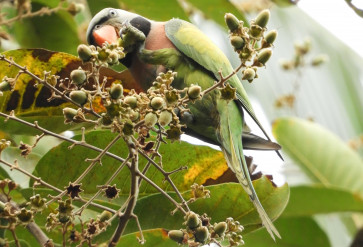Popular Reads
Top Results
Can't find what you're looking for?
View all search resultsPopular Reads
Top Results
Can't find what you're looking for?
View all search resultsBrick makers in desperate need of basic fuel
The brick-making home industry at Bunton village, Cilacap regency, in which around 1,500 families live, is currently facing a grim future due to its inability to compete with bigger companies in procuring chaff, or rice husk, as fuel
Change text size
Gift Premium Articles
to Anyone

T
he brick-making home industry at Bunton village, Cilacap regency, in which around 1,500 families live, is currently facing a grim future due to its inability to compete with bigger companies in procuring chaff, or rice husk, as fuel.
Brick makers complain that chaff, which is used to fire kilns, has become scarce. With prices surging by 50 percent, their profits have drastically dropped.
“We are currently facing trouble in getting rice husk for fuel and its price has further surged. It is more difficult to get, not like before,” Bunton villager Haryono, 41, told The Jakarta Post recently.
He blamed the problem on the industry giant PT Holcim. The cement producer was said to have been acquiring rice husk in large volumes.
Rice husk is a waste product derived from rice mills and used by brick makers to fire their kilns in the brick-making process.
In the past two years, PT Holcim has used it as fuel in its cement production.
“We are definitely helpless because the cement firm buys at a higher price and gives instant payment, while we usually pay the mill owner for it later,” said Haryono.
Brick makers seem to have no option other than to pay 50 percent more than the normal price for rice husk. “Earlier, before Holcim bought rice husk, a truck-load of husk cost Rp 1 million (about US$117) at most,” said Haryono.
He added around four truck-loads of husk was needed to bake 50,000 bricks.
“We used to pay Rp 4 million for four truck-loads, but now it costs more than Rp 6 million,” said Haryono.
A fellow brick-maker, Karyanto, said he had to go elsewhere to find rice husk.
“Besides being expensive, it is further and harder to obtain. I have to go to Purworejo to seek rice husk. Rice mill owners prefer to sell it to the cement producer because they are willing to pay more for it and on the spot,” said Karyanto.
He expressed a hope that PT Holcim would shift to other sources of fuel because the brick industry was in dire need of husk.
“For us, there is no other source of living apart from brick-making,” said Karyanto.
Adipala district chief Budi Santoso acknowledged the grievances expressed by the local brick makers and said that he had faced difficulties in resolving the issue.
“Yes, we have discussed the matter with the brick makers, but we also don’t have the right to prevent the cement industry from using rice husk for fuel. It should sympathize more with the small-scale industry,” said Budi.
PT Holcim Cilacap spokesman Deny Nuryandain confirmed that rice husk was an alternative source of fuel used by his company to produce cement.
“Chaff, or rice husk is an eco-friendly and renewable source of energy, so that’s why we use it as fuel in the firing process as a replacement for diesel and coal,” Deny told the Post.









